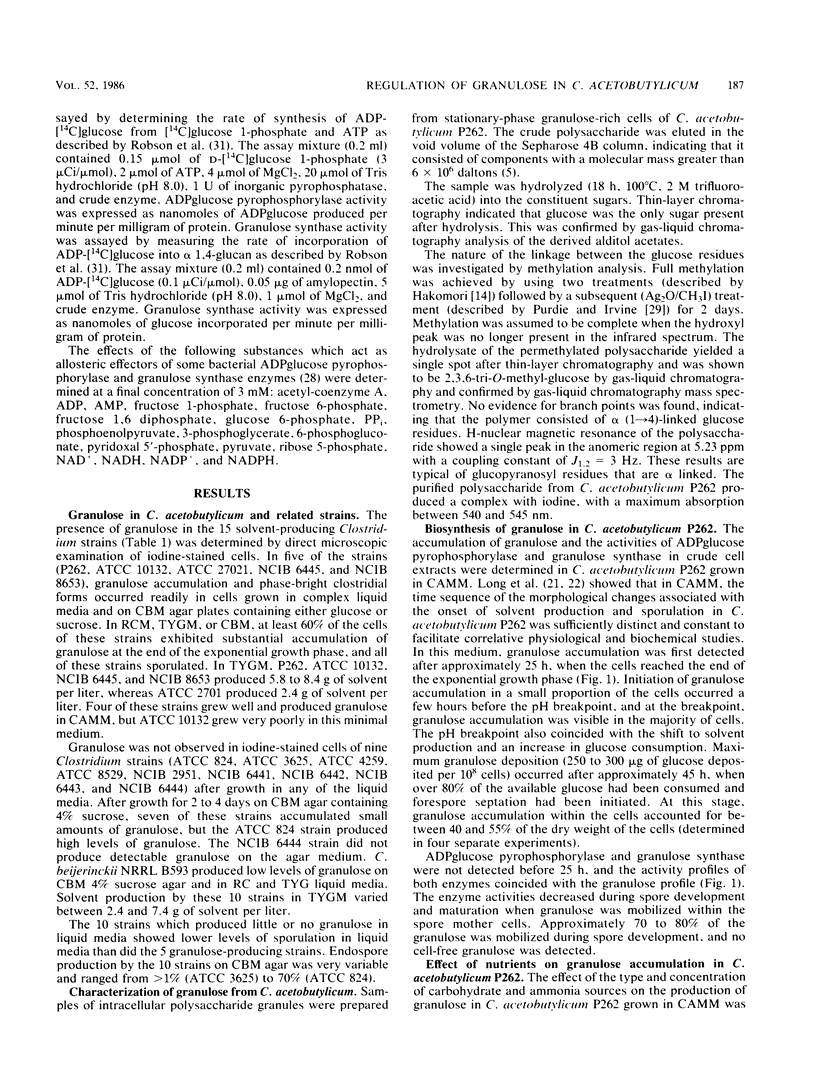Abstract
Synthesis of granulose was investigated in 15 solvent-producing Clostridium strains. Only one of the strains did not produce granulose. The structure of granulose in Clostridium acetobutylicum P262 consisted of a high-molecular-weight polyglucan containing only (1→4) linked d-glucopyranose units. Biosynthesis of granulose in C. acetobutylicum P262 was dependent on ADPglucose pyrophosphorylase, and granulose synthase and mutants defective in granulose accumulation lacked either one or both enzyme activities. Granulose-positive revertants exhibited both enzyme activities. ADPglucose pyrophosphorylase and granulose synthase were not subject to allosteric control by metabolites. Granulose accumulation and the biosynthetic enzyme activities were initiated immediately before the pH breakpoint and were detected in cells only at the end of the exponential growth phase. Granulose accumulation did not occur under conditions of nitrogen limitation, excess carbon, or excess energy.
Full text
PDF





Selected References
These references are in PubMed. This may not be the complete list of references from this article.
- Bergère J. L., Rousseau M., Mercier C. Polyoside intracellulaire impliqué dans la sporulation de Clostridium Buryricum. I. Cytologie, production et analyse enzymatique préliminaire. Ann Microbiol (Paris) 1975 Apr;126(3):295–314. [PubMed] [Google Scholar]
- Brown R. G., Lindberg B., Laishley E. J. Characterization of two reserve glucans from Clostridium pasteurianum. Can J Microbiol. 1975 Jul;21(7):1136–1138. doi: 10.1139/m75-168. [DOI] [PubMed] [Google Scholar]
- Darvill A. G., Hall M. A., Fish J. P., Morris J. G. The intracellular reserve polysaccharide of Clostridium pasteurianum. Can J Microbiol. 1977 Aug;23(8):947–953. doi: 10.1139/m77-141. [DOI] [PubMed] [Google Scholar]
- Dawes E. A., Senior P. J. The role and regulation of energy reserve polymers in micro-organisms. Adv Microb Physiol. 1973;10:135–266. doi: 10.1016/s0065-2911(08)60088-0. [DOI] [PubMed] [Google Scholar]
- GAVARD R., MILHAUD G. Sur un polysaccharide isolé de Clostridium butyricum. Ann Inst Pasteur (Paris) 1952 Apr;82(4):471–483. [PubMed] [Google Scholar]
- HAKOMORI S. A RAPID PERMETHYLATION OF GLYCOLIPID, AND POLYSACCHARIDE CATALYZED BY METHYLSULFINYL CARBANION IN DIMETHYL SULFOXIDE. J Biochem. 1964 Feb;55:205–208. [PubMed] [Google Scholar]
- Harris P. J., Henry R. J., Blakeney A. B., Stone B. A. An improved procedure for the methylation analysis of oligosaccharides and polysaccharides. Carbohydr Res. 1984 Apr 2;127(1):59–73. doi: 10.1016/0008-6215(84)85106-x. [DOI] [PubMed] [Google Scholar]
- Hartmanis M. G., Gatenbeck S. Intermediary Metabolism in Clostridium acetobutylicum: Levels of Enzymes Involved in the Formation of Acetate and Butyrate. Appl Environ Microbiol. 1984 Jun;47(6):1277–1283. doi: 10.1128/aem.47.6.1277-1283.1984. [DOI] [PMC free article] [PubMed] [Google Scholar]
- Jones D. T., van der Westhuizen A., Long S., Allcock E. R., Reid S. J., Woods D. R. Solvent Production and Morphological Changes in Clostridium acetobutylicum. Appl Environ Microbiol. 1982 Jun;43(6):1434–1439. doi: 10.1128/aem.43.6.1434-1439.1982. [DOI] [PMC free article] [PubMed] [Google Scholar]
- LOWRY O. H., ROSEBROUGH N. J., FARR A. L., RANDALL R. J. Protein measurement with the Folin phenol reagent. J Biol Chem. 1951 Nov;193(1):265–275. [PubMed] [Google Scholar]
- Long S., Jones D. T., Woods D. R. Sporulation of Clostridium acetobutylicum P262 in a Defined Medium. Appl Environ Microbiol. 1983 Apr;45(4):1389–1393. doi: 10.1128/aem.45.4.1389-1393.1983. [DOI] [PMC free article] [PubMed] [Google Scholar]
- O'Brien R. W., Morris J. G. Oxygen and the growth and metabolism of Clostridium acetobutylicum. J Gen Microbiol. 1971 Nov;68(3):307–318. doi: 10.1099/00221287-68-3-307. [DOI] [PubMed] [Google Scholar]
- Preiss J. Bacterial glycogen synthesis and its regulation. Annu Rev Microbiol. 1984;38:419–458. doi: 10.1146/annurev.mi.38.100184.002223. [DOI] [PubMed] [Google Scholar]
- Robson R. L., Robson R. M., Morris J. G. The biosynthesis of granulose by Clostridium pasteurianum. Biochem J. 1974 Dec;144(3):503–511. doi: 10.1042/bj1440503. [DOI] [PMC free article] [PubMed] [Google Scholar]
- Steiner K. E., Preiss J. Biosynthesis of bacterial glycogen: genetic and allosteric regulation of glycogen biosynthesis in Salmonella typhimurium LT-2. J Bacteriol. 1977 Jan;129(1):246–253. doi: 10.1128/jb.129.1.246-253.1977. [DOI] [PMC free article] [PubMed] [Google Scholar]
- Strasdine G. A. The role of intracellular glucan in endogenous fermentation and spore maturation in Clostridium botulinum type E. Can J Microbiol. 1972 Feb;18(2):211–217. doi: 10.1139/m72-033. [DOI] [PubMed] [Google Scholar]
- Whyte J. N., Strasdine G. A. An intracellular alpha-D-glucan from Clostridium botulinum, type E. Carbohydr Res. 1972 Dec;25(2):435–441. doi: 10.1016/s0008-6215(00)81655-9. [DOI] [PubMed] [Google Scholar]


